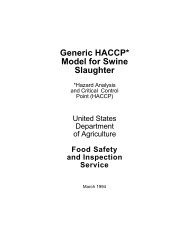Generic HACCP Model for Thermally Processed Commercial
Generic HACCP Model for Thermally Processed Commercial
Generic HACCP Model for Thermally Processed Commercial
Create successful ePaper yourself
Turn your PDF publications into a flip-book with our unique Google optimized e-Paper software.
the desirability of legislation en<strong>for</strong>cing labelling of cans with the date of manufacture<br />
and/or the last recommended date <strong>for</strong> use.<br />
Brand, N. G. 1978. [Broken glass in bottles.] Brygmesteren 35(2):55-56.<br />
Possible health hazards from presence of broken glass in beverage bottles are discussed;<br />
the most likely source is glass splinters from bottles bursting during filling.<br />
Recommendations to minimize this problem include: application of counterpressure to<br />
bottles as late as possible in the filling operation, so that the mouth of the following bottle<br />
is likely to be covered; fitting protective shields to isolate individual bottles within the<br />
section of the machine in which counterpressure is applied; installation of systems <strong>for</strong><br />
washing of the filling heads after a bottle bursts; and frequent changing of the rubber seals<br />
on the filling heads (into which glass splinters may become embedded and subsequently<br />
released into bottles).<br />
Gibson, R. 1993. [Food contamination is not an isolated occurrence.]<br />
Voedingsmiddelentechnologie 26(24):23.<br />
Contamination of foods is discussed with reference to: trends in incidence of food<br />
contamination; incidence of contamination of various foods with chemicals, glass and<br />
other materials; fraudulent claims of contamination; assessment of cases of claimed food<br />
contamination; and contamination of foods with compounds (e.g. chlorophenols used as<br />
fungicides) which adversely affect flavour.<br />
Jorhem, L. and S. Slorach. 1991. [Less lead and tin in canned foods.] Var Foeda 43(6):312-316,<br />
337.<br />
The reduction in Pb and Sn contents of canned foods as a result of the change from<br />
soldered to welded cans is discussed. Swedish tolerances <strong>for</strong> Pb and Sn in canned foods<br />
have been reduced in accordance with this change in can construction. Dented cans show<br />
no increase in Pb or Sn uptake by the food; the contents of leaking cans should, however,<br />
not be consumed. Food should not be stored in opened cans, as exposure to air increases<br />
the rate of Pb and Sn uptake.<br />
Lopez-Martinez, C., et al. 1987.[Levels of Pb contamination in canned foods: meat, sea-foods,<br />
vegetables and prepared dishes.] Anales de Bromatologia 39(2):239-246.<br />
Pb was determined by AAS in 62 samples of canned foods from retail sources in Granada.<br />
Of 23 samples of canned vegetables, 10 exceeded the tolerance level of 1 p.p.m.; 4 had<br />
Pb concn. greater than or equal 2 p.p.m. Of 11 samples of canned fruit,<br />
5 exceeded the tolerance level of 1 p.p.m.; 1 sample exceeded 2 p.p.m. Of 16 samples<br />
of prepared dishes, 4 exceeded the tolerance of 1 p.p.m.; 1 exceeded 2 p.p.m. Of 12<br />
73



